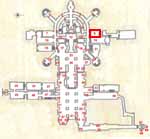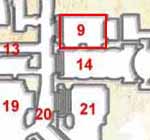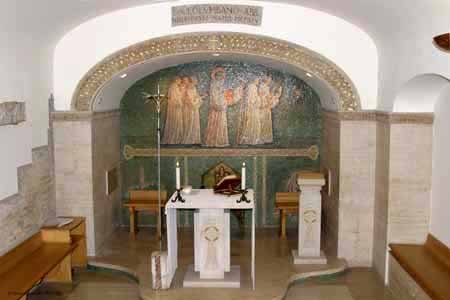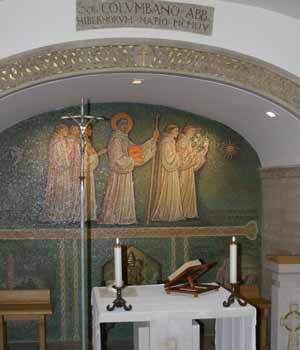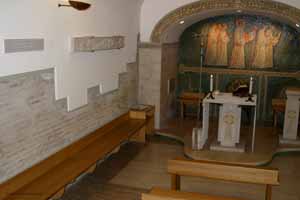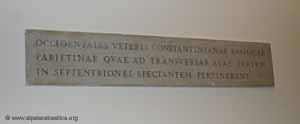| Grottoes
Vatican City Colonnade Saints Floorplan #2 |
| Altars
Monuments The History |
|
Related Links |
|
On the right side of the peribolos (semicircular corridor), just past the Polish Chapel, is an opening with a bronze grid onto the floor of the basilica above. Immediately to the right is the entrance to the Irish chapel of St Columbanus the Abbot, the first national chapel built in the Vatican grottoes. Inserted in the iron gate are two gilded Gaelic crosses. |
|
|
|
|
|
|
|
|
|
|
|
|
|
|
|
|
|
During the Holy Year of 1950, Pope Pius XII gave his assent to the request presented by the Knights of Columbus, to commemorate in the vicinity of Peter's tomb, the evangelizing work carried out in Europe by the Irish monks starting from the 6th century. The building of the new chapel started on February 9, 1951. It was necessary to open the floor of the basilica in the first span of the transept of SS Processus and Martinian to create the needed space. At the same time, a mosaic representing the sainted Irish monk was made at an altar that already existed in the grottoes. The excavations, in the course of which 800 cubic meters of earth were extracted, brought to light a big section of the northern transept of the Constantinian basilica, 6 big columns and several marble sarcophagi. The area was consolidated to guarantee the stability of the floor and, finally, the construction of the chapel started. The technical director of the Fabbrica di San Pietro, Engineer Francesco Vacchini projected and supervised the work. The chapel was inaugurated on September 12, 1954 with Mass celebrated by the Archbishop of Dublin Giovanni C. McQuaid. |
||||
|
In 1999, part of the chapel was restored and the presbytery and furnishing were modified according to the new liturgical norms of Vatican Council II. On June 22, the new altar was consecrated by the Archbishop of Armagh and the Primate of the Catholic Church of Ireland, His Eminence Sean Brady, in the presence of the Irish Bishops and the Government officials. The simple and austere chapel harmonizes with the style of the grottoes. On the back wall, in the apse under an arch, is the mosaic in a sea-green tonality, made by the Studio of the Fabbrica di San Pietro. It represents St Columbanus with a pastoral staff and the book of the Regula, between four monks, in their symbolic walk from Ireland to Italy. They are preceded by the symbolic sun, indicating the destination of their journey; following the group is a dove. The first inscription: PEREGRINANTES PRO CHRISTO (Pilgrims for Christ) illustrates the apostolic goal of the peregrination of the monks. The second inscription, a quotation from a letter of St Columbanus: SI TOLLIS LIBERTATEM TOLLIS DIGNITATEM (If you take away liberty, you take away dignity) indicates the humanitarian and spiritual aspect of their mission. On the low part of the mosaic are the points of departure and arrival of the long peregrination (pilgrimage) of Columbanus: BANGOR with the tower and the Celtic cross and BOBBIO with the ancient bridge and the abbey where Columbanus ended his days. To the sides from the mosaic there are two Latin inscriptions. The one to the right commemorates the founding of the chapel, while the one to the left its modification.
One special thing in the chapel - on the left wall one can see the archeological remains of the inner wall of the northern transept of the old basilica. Above is a travertine fragment with the sculptures representing the symbols of the four Evangelists that was part of the old altar.
|
||||
| Source: Roma Sacra The Vatican Grottoes, © Fabbrica of St. Peter's, June 2003 |
This independent website is not endorsed by or associated with the Vatican, the Fabbrica of St. Peter's, or any business organization
Contact:
stpetersbasilica@gmail.com
